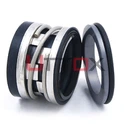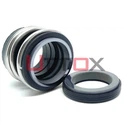Industrial pump failures can cost companies thousands of dollars in downtime, environmental cleanup, and equipment replacement. The heart of preventing such catastrophic failures lies in understanding pump seals and their critical role in maintaining operational integrity. A pump seal, particularly mechanical seals like those used in ITT Flygt applications, serves as the essential barrier that prevents fluid leakage where a rotating shaft passes through stationary housing. These sophisticated sealing systems are fundamental components that ensure reliable operation across petroleum refining, water treatment, pulp and paper, shipbuilding, food and beverage, pharmaceutical, and power plant industries.
Understanding ITT Flygt Pump Mechanical Seals and Their Core Functions
ITT Flygt mechanical seals represent advanced sealing technology designed to contain fluids within pump systems while allowing shaft rotation without leakage. These pump mechanical seals work by creating a dynamic sealing interface between rotating and stationary components, utilizing precision-engineered surfaces that maintain contact under controlled conditions. The fundamental principle involves two primary sealing faces - typically one made from softer materials like carbon graphite and another from harder materials such as silicon carbide or ceramic alumina. The effectiveness of ITT Flygt mechanical seals depends on three critical sealing points that work in harmony. The primary sealing interface occurs between the rotating and stationary seal faces, where a thin film of fluid maintains lubrication while preventing bulk leakage. Secondary seals, usually elastomeric O-rings or gaskets, prevent leakage along the shaft and housing interfaces. This triple sealing arrangement ensures comprehensive fluid containment while accommodating the operational demands of rotating machinery.

Design Characteristics of Modern Pump Mechanical Seals
Modern pump mechanical seals incorporate sophisticated design elements that enhance performance and reliability. Spring-loaded mechanisms maintain optimal sealing force across varying operating conditions, compensating for wear and thermal expansion. The spring system, whether comprising multiple coil springs or a single wave spring, provides consistent closing force while allowing the seal faces to track shaft movement and maintain proper contact geometry. Face materials selection plays a crucial role in seal performance and longevity. Carbon graphite faces offer excellent self-lubricating properties and conformability, making them ideal for the softer sealing surface. Hard face materials like silicon carbide provide superior wear resistance and dimensional stability, essential for maintaining precise sealing geometry over extended operational periods. In abrasive applications, both faces may utilize hard materials to maximize service life.
ITT Flygt Seal Technology in Industrial Applications
ITT Flygt pump systems integrate advanced mechanical seal technology specifically engineered for demanding industrial environments. These seals must withstand extreme pressures, temperatures, and chemical exposures while maintaining leak-tight integrity. The design philosophy focuses on balancing seal face loading to optimize sealing effectiveness while minimizing heat generation and wear rates. Flygt mechanical seals feature balanced or unbalanced configurations depending on application requirements. Balanced seals reduce face loading by utilizing hydraulic forces to partially offset spring pressure, resulting in lower friction, reduced heat generation, and extended seal life. This configuration proves particularly beneficial in high-pressure applications where excessive face loading could lead to premature failure.
Application-Specific Seal Configurations
Different industrial applications require tailored seal configurations to address specific operational challenges. Single mechanical seals provide cost-effective sealing for standard applications where containment requirements are moderate. These seals feature a single sealing interface between the process fluid and atmosphere, relying on the pumped medium for lubrication and cooling. Double mechanical seals offer enhanced safety and reliability for hazardous or valuable fluids. This configuration utilizes two sealing interfaces with a barrier fluid system between them. If the primary seal fails, the secondary seal continues providing containment while the barrier fluid system alerts operators to the failure condition. This redundancy proves essential in applications involving toxic, flammable, or environmentally sensitive fluids.
Selection Criteria for Pump Mechanical Seals
Proper seal selection requires comprehensive evaluation of operating conditions, fluid properties, and performance requirements. Operating pressure represents a fundamental consideration, as it directly influences seal face loading and material stress levels. High-pressure applications may require balanced seal designs or specialized face materials to prevent excessive wear and heat generation. Temperature considerations encompass both the pumped fluid temperature and environmental conditions. Extreme temperatures affect material properties, thermal expansion, and seal face geometry. High-temperature applications require heat-resistant elastomers and face materials with compatible thermal expansion coefficients. Low-temperature applications may necessitate special materials to maintain flexibility and sealing capability.
Fluid Compatibility and Chemical Resistance
Chemical compatibility between seal materials and process fluids determines seal longevity and reliability. Elastomeric secondary seals must resist chemical attack, swelling, and hardening when exposed to process fluids. Face materials should maintain dimensional stability and surface integrity despite chemical exposure. Comprehensive material compatibility charts guide selection for specific chemical environments. Fluid properties such as viscosity, lubricity, and solid content significantly impact seal performance. Low-lubricity fluids may require special face material combinations or external lubrication systems. Fluids containing abrasive particles necessitate hard face materials and possibly filtration systems to protect sealing surfaces. Viscous fluids may require modified seal geometries to ensure adequate circulation and cooling.
Installation and Maintenance of ITT Flygt Mechanical Seals
Proper installation procedures are critical for achieving optimal seal performance and service life. Installation begins with thorough cleaning of all sealing surfaces and careful inspection for damage or contamination. Shaft runout and surface finish must meet manufacturer specifications to ensure proper seal face tracking and minimal vibration. Assembly procedures require strict adherence to manufacturer guidelines regarding torque specifications, component orientation, and lubrication requirements. Improper installation can result in immediate failure or significantly reduced service life. Installation tools and fixtures help ensure consistent, damage-free assembly while maintaining proper component alignment.
Preventive Maintenance Strategies
Effective maintenance programs incorporate regular monitoring of seal performance indicators and proactive replacement scheduling. Vibration monitoring can detect developing issues such as shaft misalignment or bearing wear that could compromise seal performance. Temperature monitoring helps identify excessive friction or inadequate cooling conditions. Leakage monitoring provides early warning of seal degradation, allowing planned maintenance before catastrophic failure occurs. Modern monitoring systems can detect minute leakage rates and trending deterioration, enabling predictive maintenance strategies that minimize downtime and maintenance costs. Regular inspection of auxiliary systems such as barrier fluid supplies and cooling systems ensures continued seal support.
Troubleshooting Common Pump Seal Problems
Seal failure analysis requires systematic evaluation of failure modes, operating conditions, and maintenance history. Excessive leakage represents the most common seal problem, often resulting from face wear, thermal distortion, or contamination. Face wear patterns provide valuable diagnostic information about operating conditions and potential corrective actions. Heat checking or thermal cracking of seal faces indicates excessive temperatures caused by inadequate lubrication, excessive face loading, or insufficient cooling. Corrective measures may include seal rebalancing, improved circulation, or auxiliary cooling systems. Material selection changes might be necessary for severe thermal environments.
Advanced Diagnostic Techniques
Modern diagnostic techniques utilize vibration analysis, thermography, and acoustic emission monitoring to assess seal condition and predict failure. Vibration analysis can identify shaft dynamics issues that stress seal components. Thermal imaging reveals temperature distributions that indicate cooling problems or excessive friction. Acoustic emission monitoring detects microscopic crack propagation and face separation events that precede visible seal failure. These techniques enable condition-based maintenance strategies that optimize seal life while preventing unexpected failures. Integration with plant monitoring systems provides real-time assessment capabilities and automated alarm functions.
Conclusion
Pump seals, particularly ITT Flygt mechanical seals, represent critical components that ensure industrial pump reliability, safety, and environmental compliance. Understanding seal technology, selection criteria, and maintenance requirements enables optimal performance and service life in demanding applications.
Cooperate with Zhejiang Uttox Fluid Technology Co.,Ltd.
Zhejiang Uttox Fluid Technology Co.,Ltd., established in 1990, stands as a premier China ITT Flygt manufacturer and China ITT Flygt supplier with over 30 years of industry expertise. Our experienced R&D team provides technical guidance and customized solutions for diverse working conditions, supporting industries including petroleum refining, water treatment, pulp and paper, shipbuilding, food and beverage, pharmacy, and power plants. As a trusted China ITT Flygt factory, we maintain sufficient inventory for fast delivery while our professional technical team offers free support and OEM services. Our high quality ITT Flygt products match international standards with competitive ITT Flygt prices. For ITT Flygt for sale inquiries, contact our China ITT Flygt wholesale team at info@uttox.com for reliable sealing solutions.
FAQ
Q: What is the primary function of a pump seal?
A: A pump seal prevents fluid leakage where the rotating shaft passes through the stationary pump housing while allowing shaft rotation.
Q: How do ITT Flygt mechanical seals differ from other seal types?
A: ITT Flygt mechanical seals feature precision-engineered faces with advanced materials and balanced designs for superior performance and longevity.
Q: What factors determine mechanical seal selection?
A: Key factors include operating pressure, temperature, fluid properties, chemical compatibility, and specific application requirements.
Q: How often should pump mechanical seals be replaced?
A: Replacement intervals depend on operating conditions, maintenance practices, and seal design, typically ranging from months to several years.
References
1. "Mechanical Seals for Centrifugal Pumps: Design and Application Guidelines" - Seal Technology Institute
2. "Industrial Pump Sealing Systems: Performance and Reliability Analysis" - Dr. Robert Chen, Mechanical Engineering Research
3. "Advanced Materials in Pump Seal Applications" - Materials Science Society Journal, Prof. Sarah Johnson
4. "Pump Seal Failure Analysis and Prevention Strategies" - Industrial Maintenance Engineering, Mark Thompson







